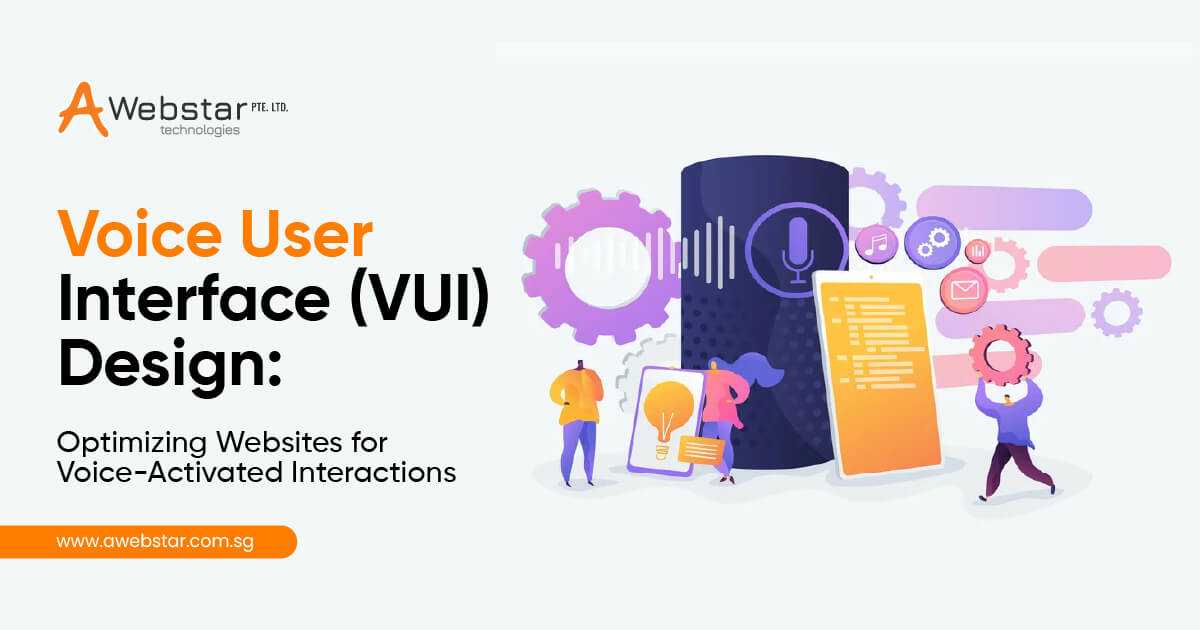
The way we interact with each other is truly transformed by the constantly evolving technology. Today’s digital era has witnessed some prominent advancements in recent years, one of them being voice-activated interactions. Various virtual assistants like Siri, Google Assistant, and Amazon Alexa are prevalent in the market today with widespread adoption. Hence, website owners tend to optimise their online platforms for Voice User Interface design. This is necessary as the majority of users today rely on voice commands to perform countless tasks.
Voice User Interface website design emphasises generating seamless as well as intuitive interactions between users and websites through spoken commands. Offering a hands-free and natural way of accessing information, navigating websites and engaging with online services it goes beyond traditional visual and text-based interfaces. Even if you are just searching for some information, making purchases, or controlling smart devices, VUI design has the potential to transform the way we interact with websites.
Here, in this blog post, we will examine the unique world of VUI design and explore how websites can be optimised to deliver voice-activated experiences exceptionally. To be on the edge of the competition, this blog post will equip you with the knowledge and tools to effectively incorporate VUI design into your website.
So, join us as we unravel the possibilities of VUI design and discover how voice-activated interactions can reshape the way we interact with websites. This would provide convenience, accessibility, and a truly hands-free experience for users. Let’s jump in!!
How Does A Voice User Interface(VUI) Work?
Integration of various Artificial Intelligence technologies including speech synthesis, automatic speech recognition, and named entity recognition result in a Voice User Interface(VUI). These technologies thus get included in devices or applications and work together to enable voice interactions. Typically hosted in either a private or public cloud, the backend infrastructure and the speech components of the VUI are powered by AI technologies.
The user’s voice and speech inputs are processed by VUI allowed by this setup. As already mentioned AI technology employed in the VUI grasps the user’s intent thus providing a response back to the device or application. This strategy serves as the foundation of a voice UI design. Most Companies increase their VUIs by encompassing a Graphical User Interface(GUI) and additional sound effects.
This as a result delivers an optimal user experience. It is important to determine when the device is actively listening, processing speech, or delivering a response. This is wholly determined by the combination of visuals and sound effects. More intuitive and engaging user interaction with the VUI is a contribution of these supplementary elements as a whole.
Design Guidelines for Voice User Interface
There are numerous guidelines to consider in order to create a user-friendly and intuitive experience while designing a Voice User Interface are going to be discussed in this section. So, stay tuned!
Short and Clear Language
It is always recommended to use a language that is easy for the users to understand. Write in a way that a layman can totally grasp what is being said without using any technical terms or jargon.
Feedback and Confirmation
To acknowledge that the system has understood the user’s input proving clear feedback to users after each voice command is beneficial. In order to alert users of errors or successful recognition beeps and tones can be employed. Offer suggestions and alternatives to rectify errors or misunderstandings.
Contextual Awareness
Providing relevant and personalised responses taking into account previous commands or interactions must be ensured by VUI. Adapt the system’s behavior based on history and user preferences.
Consistency across Platforms
Voice commands consistency, interactions, and visual representations across different platforms or devices must be fully maintained. Users must be able to seamlessly opt for any device without having to understand different commands or behaviors.
Accessibility Considerations
VUI must be accessible to users who may have difficulty speaking and must provide alternative input methods such as touch or gestures.
Continuous Improvements
To monitor the performance and effectiveness of the VUI gather user feedback and analytics. Update and refine the system regularly based on user insights and ever-evolving needs.
Thus, VUIs are capable of delivering a user-friendly and engaging experience thus leveraging the power of voice interaction. This, in turn, ensures usability and accessibility for a wide range of users.
Why VUI Is The Next Major Breakthrough In The Digital Realm?
Due to its natural and intuitive interaction capabilities, Voice User Interface is assured to become the next breakthrough in the digital realm. VUI mimics human-to-human communication thus eliminating the need for complex user manuals or technical training.
Users can use their own voice to interact with digital gadgets and systems as an outcome of VUIs. This seamless and comfortable way of contact improves user experience and accessibility for people with little technology literacy or physical limitations. VUI is an effective tool for a variety of tasks like voice search, virtual assistants, smart home automation, and hands-free device control due to its capacity to interpret and respond to natural language commands.
Because VUI integrates with other technologies, its accuracy, and comprehension may be constantly improved, enhancing both its utility and convenience. With its potential to change how we interact with digital systems, VUI is poised to transform how we interact with technology.
Advantages Of VUI
There are numerous advantages of VUI in various applications.
VUI makes activities convenient and safe like driving and cooking by enabling hands-free and eyes-free operation. This eliminates the need for complex interfaces.
It boosts productivity by allowing faster task execution through voice commands. All in all, it enables multitasking as users can interact with devices while focusing on other activities.
Based on user preferences VUI can be personalised and is user-friendly and convenient. It has expanded capabilities due to integration with other technologies.
Engaging experiences can be created by voice interactions.
Conclusion
In Conclusion, Voice search optimization has become a critical aspect of modern web design.
Voice User Interfaces(VUIs) have transformed the way we interact and engage with websites.
Businesses can create intuitive and seamless experiences for users who prefer voice-activated interactions by including VUI design principles.
VUIs and Voice search optimisation offer new opportunities to enhance user satisfaction, accessibility, and overall website performance by understanding user intent.















































